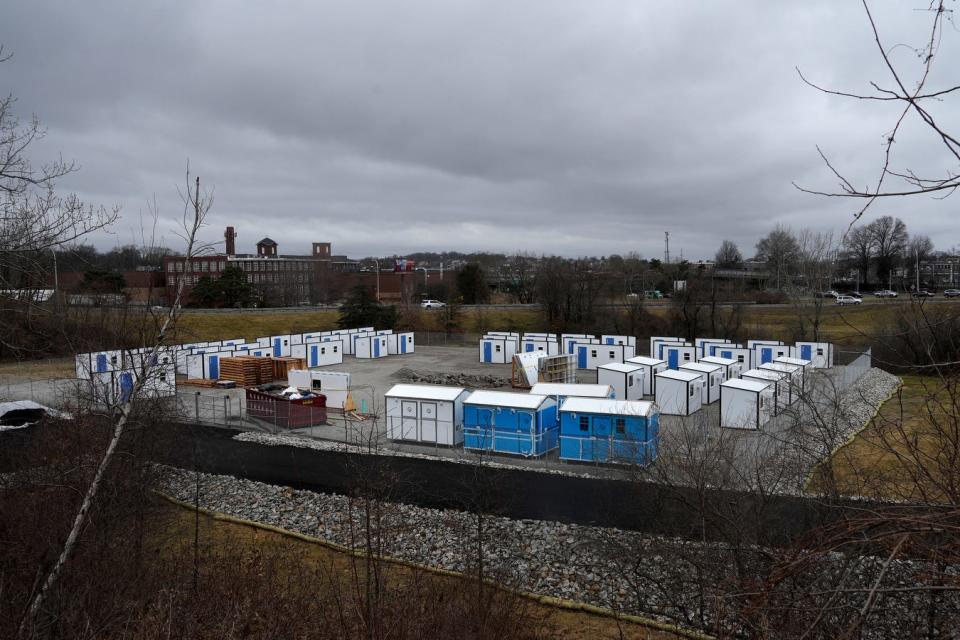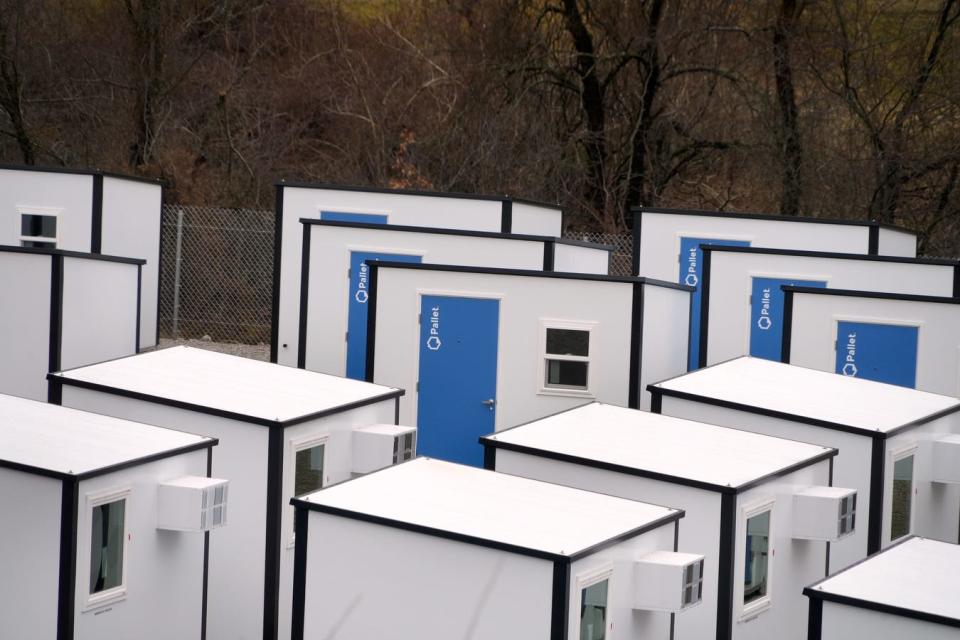RI's first pallet shelters are going up in Providence. Here's what they're like.
PROVIDENCE − Alongside Route 146 and its on-ramp from Douglas Avenue, a collection of squat white buildings has appeared, with a new road leading down to the 4-acre clearing on state land where Echo Village is rising.
The boxy buildings off Victor Street sit on a gravel pad built up from the grassy area around it, buffeted by the sounds of the highway.
These "pallet shelters" should, in the spring, become 45 temporary homes to Providence's, and the state's, ever-swelling unhoused and unsheltered population. The number of people living outside ("unsheltered") is up 370% over 2019, according to the 2023 point-in-time count.
House of Hope is running the project, having been awarded a state contract.

Pallet shelters are a long time coming
While it was still in the planning phase in January, Echo Village appears nearly ready now, even if there is more construction to be done.
The company that manufactures the shelters deployed a team a month ago to set up all of the housing structures. There will be additional office structures on the site – a community room and sanitary facilities, including bathrooms, showers and laundry units, House of Hope executive director Laura Jaworski said.
She said she has been working with company representatives for the past 3½ years, trying to get the shelters into Rhode Island. In that time, the shelter designs have evolved and become more adaptable to climate extremes, both hot and cold. She has also been talking to communities that have used the shelters in the United States and Canada.
Burlington, Vermont, has set up the same type of units, called "pod shelters."
"At the end of the day, we're building a dignified space that supports giving humanity back to people who've had it stripped away," Jaworski said.

The complex will add 45 units to a shelter system that is badly strained, and those who do get beds will be the people with the greatest need.
The state had 1,417 shelter beds as of January, up from 1,125 in October 2023. Of those beds, 91% are being utilized, according to the latest data provided by the Rhode Island Coalition to End Homelessness.
At the same time, the number of people on the waiting list grew to 830 grouped into 519 households, including 60 households with children, 134 households without children, 323 singles and two households still to be determined.
While the number of people in households with children seeking shelter has decreased, the total number of people seeking shelter has gone up 31% since October.
Will it ease homelessness? State chooses Providence site for village of 45 pallet shelters.
In an old neighborhood, sewer connections should be easy
The 4-acre area of land was once a neighborhood that was taken down to build Route 146. As crews prepared the site, they found the sewer lines are intact and should be easy to connect to.
Clean soil had to be brought into the site because the soil had a low level of contamination, about the same found anywhere in Providence, Jaworski said.
Recent storms gave crews a perfect opportunity to see what happens to the site in heavy rain, and it appears to have good drainage. The clean fill was used to built the site up. The state also built an access road down to the site from Victor Street, behind the Foxy Lady, an area with a few homes and lots of vehicle-repair shops.
Power has not been run to the site yet.
What is required before the site can open?
"We're working through the approval process with fire and building code officials so we can move to the next phase and start to get the site prepared, connected and move closer to occupancy," Jaworski said.
Engineers, state officials, local officials and contractors have been working toward getting the site, and the shelters, approved. Part of the problem is that both are a new type of facility that hasn't been presented before in the state, and they are figuring out how fire and other safety codes accommodate them, she said.
"The question is, how do we, in essence, fit a round peg in a square hole?" she said.
What's in the shelters?
Each shelter, 70 square feet, is equipped with:
Electrical outlets
An AC unit
A heating unit
A bed, with linens provided by House of Hope
Windows
Shelving
A door that locks
"One of the really important pieces is a door that locks," she said. "The folks we've been working with have not had the ability to create their own safety or manage their agency, so that's a big factor."
How much is the contract for?
The contract through the state Office of Housing is for $3 million. Of that, $1 million is budgeted for the shelters and the site, including the housing structures ($15,000 per unit), and the showers, bathrooms, community room, laundry spaces and office spaces, and the cost of shipping them to the site.
Another chunk of money is budgeted for construction at the site, including the road.
A smaller portion of the money is budgeted for operations, including 24-hour onsite staffing, toiletries, meals and utilities.
Meeting people where they are
The program was created with the people it is serving in mind, Jaworski said, and intended to lower the barrier to entry. That means allowing couples to live there, each with their own unit, and allowing pets. That also means there will be a dog run. There will be rules in the space, she said.
"When we hear all these things being repeated as barriers – dogs, partners or people who have significant respiratory illness and if they get exposed, they can die, so they can't be in a room with 100 other people, or people who can't plug in their CPAP machine because it's not near an outlet in the shelter," Jaworski said.
Throughout her work, Jaworski said, she has found that once people transition from living outdoors to their own safe shelter space, they sleep for days because they are finally living somewhere safe.
Thanks to our subscribers, who help make this coverage possible. If you are not a subscriber, please consider supporting quality local journalism with a Providence Journal subscription. Here's our latest offer.
Reach reporter Wheeler Cowperthwaite at wcowperthwaite@providencejournal.com or follow him on Twitter @WheelerReporter.
This article originally appeared on The Providence Journal: RI's first pallet shelter neighborhood will open in Providence this spring

